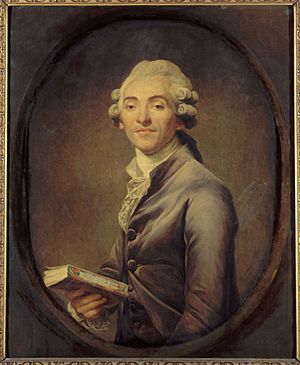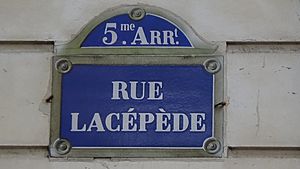Bernard Germain de Lacépède facts for kids
Quick facts for kids
Bernard Germain de Lacépède
|
|
|---|---|

Portrait by Joseph Ducreux, c. 1785
|
|
| Born | December 26, 1756 Agen in Guienne
|
| Died | October 6, 1825 (aged 68) |
| Nationality | French |
| Known for | Continuing Buffon's Histoire Naturelle |
| Awards | |
| Scientific career | |
| Fields | Natural history |
| Institutions | National Museum of Natural History, France |
Bernard-Germain-Étienne de La Ville-sur-Illon, also known as Comte de Lacépède (born December 26, 1756 – died October 6, 1825), was a French naturalist. He is famous for continuing the important work of Comte de Buffon, called Histoire Naturelle, which was a huge collection about the natural world.
Contents
About Lacépède's Life
Lacépède was born in a town called Agen in France. His father made sure he had a good education. He became very interested in natural history after reading Buffon's famous book, Histoire naturelle, générale et particulière.
Besides science, Lacépède also loved music. He was a skilled piano and organ player. He even composed two operas, which were praised by the famous composer Gluck. From 1781 to 1785, he published his own book about music called Poétique de la musique.
Early Scientific Work
Lacépède wrote two scientific books: Essai sur l'électricité (1781) about electricity, and Physique générale et particulière (1782–1784) about general physics. These books impressed Buffon, who became his friend.
In 1785, Buffon asked Lacépède to help him at the Jardin du Roi (which means "King's Garden"). Buffon also suggested that Lacépède continue his massive Histoire naturelle project. Lacépède took on this big task. He published his part of the work under the titles Histoire naturelle des quadrupèdes ovipares et des serpents (1788) and Histoire naturelle des serpents (1789). These books were about animals that lay eggs, like reptiles, and snakes.
Life During the French Revolution
After the French Revolution began, Lacépède became involved in politics. He was a member of the Legislative Assembly. However, during a very dangerous time called the Reign of Terror, he left Paris. His life was at risk because he did not agree with the violent events happening.
When the Jardin du Roi was reorganized in 1793, it became the Jardin des Plantes and the Muséum National d'Histoire Naturelle. Lacépède was given an important job there. He became the professor in charge of studying reptiles and fishes.
From 1798 to 1803, he published five volumes of his book Histoire naturelle des poissons (Natural History of Fish). In 1804, he published Histoire des cétacées (History of Whales).
Later Political Career
After 1804, Lacépède spent most of his time in politics. He became a senator in 1799 and was even president of the senate several times. In 1803, he became the grand chancellor of the Legion of Honor, a very important award in France. In 1804, he became a minister of state.
Later, in 1819, he was made a peer of France. This meant he was a high-ranking member of the French government. His political work kept him from making more major scientific discoveries.
Lacépède passed away in Épinay-sur-Seine in 1825. After his death, a large 18-volume work he wrote, Histoire générale physique et civile de l'Europe, was published.
Honors and Memberships
Lacépède was recognized for his scientific work by many important groups.
- In 1796, he became a permanent secretary of the French Academy of Sciences.
- In 1806, he was made a Fellow of the Royal Society in London.
- In 1812, he became a foreign member of the Royal Swedish Academy of Sciences.
Ideas on Evolution
Lacépède was one of the early thinkers about evolution. He believed that species could change over time. He thought that species might even go extinct because of big natural events, or they could "metamorphose" (change completely) into new species.
In his book Histoire naturelle des poissons, he wrote:
"The species can undergo such a large number of modifications in its forms and qualities, that without losing its vital capacity, it may be, by its latest conformation and properties, farther removed from its original state than from a different species: it is in that case metamorphosed into a new species."
This means he thought that animals could change so much that they would become a new kind of animal, different from their ancestors.
Tributes to Lacépède

- Lacepede Bay in South Australia and the Lacepede Islands off the coast of Western Australia are named after him.
- A street in Paris, Rue Lacépède, is named in his honor. It is located near the Jardin des Plantes and the Muséum National d'Histoire Naturelle.
- A species of gecko found only in Mauritius, called Phelsuma cepediana (or the blue-tailed day gecko), is named after him.
Images for kids
-
Bust of Bernard-Germain de Lacépède by David d'Angers (1824).




